The United States is witnessing a significant surge in infrastructure development, with the American Society of Civil Engineers estimating over $2 trillion in needed investments by 2025 to upgrade the country’s aging infrastructure.
Reliable heavy civil construction services play a crucial role in this development, ensuring projects are completed on time and to the required standard.
The importance of heavy construction companies cannot be overstated, as they drive the nation’s infrastructure growth, from roads and bridges to dams and utilities.
Key Takeaways
- Infrastructure development is critical for the US economy.
- Reliable construction services ensure timely project completion.
- Heavy civil construction is vital for national infrastructure growth.
- Investments in infrastructure are expected to rise significantly.
- Quality construction services impact the longevity of infrastructure.
The Scope and Importance of Heavy Civil Construction
Heavy civil construction is a vital component of modern infrastructure development, playing a crucial role in shaping the nation’s economic and social landscape. It encompasses a wide range of projects that are fundamental to the country’s growth and global competitiveness.
Defining Heavy Civil Engineering Projects
Heavy civil engineering projects are complex undertakings that involve the construction of critical infrastructure such as roads, bridges, dams, and tunnels. These projects require meticulous planning, precise execution, and significant investment, often involving civil engineering contractors with specialized expertise.
The scope of heavy civil engineering is broad, covering various sectors including transportation, water management, and energy infrastructure. Each project is tailored to meet specific needs, whether it’s improving connectivity, enhancing public safety, or supporting economic activities.
Economic Impact of Infrastructure Development
The economic impact of infrastructure projects, particularly those in heavy civil construction, is profound. These projects not only create jobs during the construction phase but also stimulate long-term economic growth by improving the efficiency of transportation networks, enhancing connectivity, and attracting investments.
Studies have shown that investment in infrastructure yields significant returns, often cited as a key driver of economic development. By facilitating the movement of goods and services, heavy infrastructure projects play a crucial role in boosting trade and commerce, both domestically and internationally.
Critical Role in National Development
Heavy civil construction plays a critical role in national development, contributing to the nation’s infrastructure and enhancing its global competitiveness. By investing in infrastructure, governments can address pressing issues such as traffic congestion, public safety, and environmental sustainability.
Moreover, well-planned and executed infrastructure projects can have a lasting impact on the quality of life for citizens, providing access to essential services, improving public health, and supporting economic opportunities. As such, the importance of civil engineering contractors and their role in delivering these projects cannot be overstated.
Evolution of Heavy Civil Construction in America
The evolution of heavy civil construction in America is a story of innovation, perseverance, and strategic infrastructure development. This narrative spans centuries, from the early canal systems to the modern-day megaprojects that shape the nation’s infrastructure landscape.
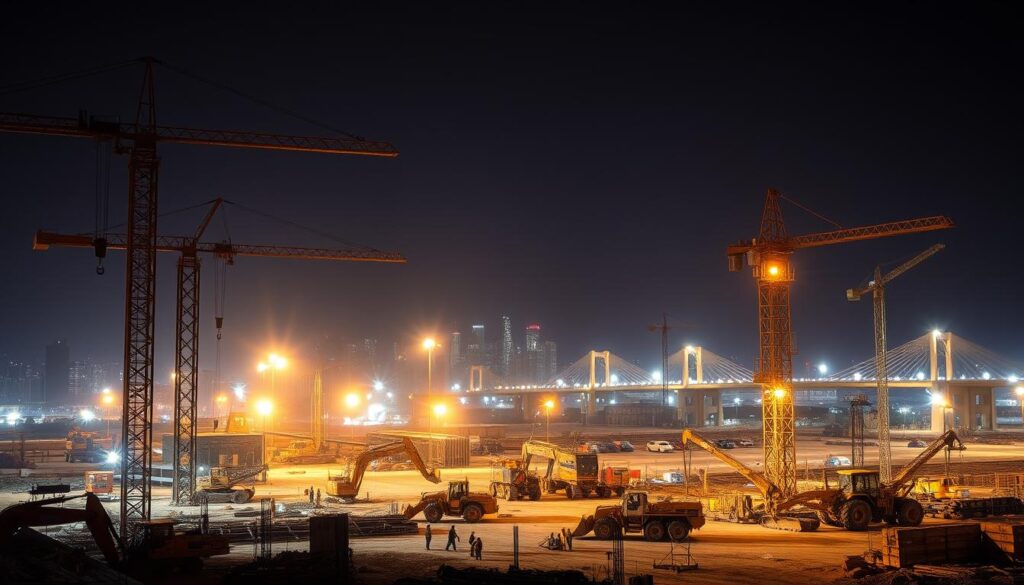
Historical Infrastructure Milestones
America’s infrastructure development has been marked by several historical milestones. The construction of the Transcontinental Railroad in the 19th century revolutionized transportation, connecting the east and west coasts. The Erie Canal, completed in 1825, was another significant project that facilitated trade between the Great Lakes and the Atlantic Ocean.
Some of the key historical infrastructure projects include:
- Construction of the Hoover Dam (1931-1936)
- Development of the Interstate Highway System (1956-1992)
- Building of the Panama Canal (1904-1914)
Technological Transformations Through Decades
The heavy civil construction industry has witnessed significant technological transformations over the decades. Advances in machinery, materials, and construction techniques have improved efficiency, safety, and sustainability.
Notable technological advancements include:
- Introduction of heavy machinery like excavators and bulldozers
- Development of new materials such as high-strength concrete and advanced composites
- Implementation of GPS and telematics for precision construction
Modern Innovations Shaping the Industry
Today, the heavy civil construction industry is being shaped by modern innovations that focus on sustainability, efficiency, and resilience. Some of these innovations include:
- Modular construction techniques that reduce on-site labor and improve quality control
- Building Information Modeling (BIM) that enhances project visualization and collaboration
- Sustainable practices such as using recycled materials and minimizing environmental impact
These advancements are transforming the heavy civil construction landscape, enabling the development of complex infrastructure projects that meet the needs of a growing population while minimizing environmental footprint.
Core Heavy Civil Construction Services in the US
Core heavy civil construction services are essential for the development of transportation, water, and energy infrastructure in the US. These services form the backbone of the country’s infrastructure, enabling the smooth operation of various sectors.
Transportation Infrastructure Development
Transportation infrastructure development is a critical component of heavy civil construction services. It includes the construction of roads, highways, bridges, and public transportation systems.
Transportation infrastructure is vital for the economy, as it facilitates the movement of goods and people. The development of this infrastructure involves planning, designing, and constructing transportation systems that are safe, efficient, and sustainable.
Water Management Systems
Water management systems are another crucial aspect of heavy civil construction services. These systems include the development of dams, reservoirs, and water treatment facilities.
Effective water management is essential for providing clean water, controlling flooding, and supporting irrigation. Heavy civil construction companies play a vital role in designing and building these systems to meet the country’s water needs.
| Water Management System | Description | Benefits |
|---|---|---|
| Dams and Reservoirs | Structures that store water for various uses | Water supply, hydroelectric power, flood control |
| Water Treatment Facilities | Plants that treat raw water for consumption and other uses | Clean water supply, public health protection |
Energy Infrastructure Projects
Energy infrastructure projects are a significant part of heavy civil construction services, encompassing the development of power plants, transmission lines, and other energy-related facilities.
The energy sector relies on heavy civil construction for the development of infrastructure that generates, transmits, and distributes energy. These projects are critical for meeting the country’s energy demands and supporting economic growth.
- Power plant construction
- Transmission line installation
- Energy storage facility development
Road and Highway Construction Excellence
The backbone of America’s infrastructure is its road and highway network, which requires continuous development and maintenance. Ensuring the excellence of these construction projects is vital for the nation’s economic growth, safety, and environmental sustainability.
Highway Development and Expansion
Highway development and expansion are critical for accommodating the increasing traffic volume and enhancing connectivity between cities and regions. Modern highway construction involves not just widening existing roads but also incorporating advanced technologies to improve safety and reduce environmental impact.
Key aspects of highway development include:
- Designing roads with safety features such as crash barriers and improved lighting
- Incorporating intelligent transportation systems (ITS) for real-time traffic management
- Using sustainable materials and practices to minimize environmental footprint
Asphalt and Concrete Paving Technologies
The choice between asphalt and concrete paving depends on various factors including climate, traffic load, and maintenance considerations. Both materials have seen significant technological advancements, improving their durability and performance.
| Paving Material | Advantages | Typical Applications |
|---|---|---|
| Asphalt | Flexible, cost-effective, quick to install | High-traffic roads, resurfacing projects |
| Concrete | Durable, long-lasting, resistant to heavy loads | Highways, airport runways, heavy-duty industrial floors |
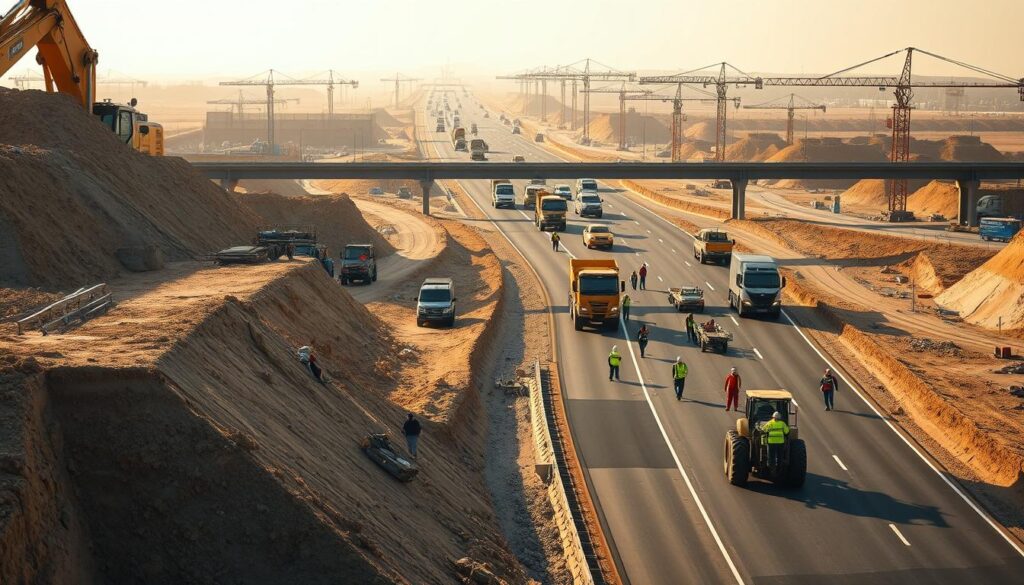
Traffic Management Solutions During Construction
Effective traffic management during road and highway construction is crucial for minimizing disruptions and ensuring safety. Strategies include:
- Implementing phased construction to keep traffic flowing
- Using real-time traffic information systems to guide drivers
- Coordinating with local authorities to manage detours and access
By adopting these strategies, construction companies can reduce the impact of their projects on commuters and local communities.
Bridge Construction and Rehabilitation Expertise
Expertise in bridge construction and rehabilitation is essential for maintaining the integrity of our nation’s infrastructure. Bridges are critical connectors that facilitate the movement of people, goods, and services, playing a vital role in the economy and daily life.
Structural Bridge Types and Applications
Bridges come in various structural types, each with its unique applications and benefits. The choice of bridge type depends on several factors, including the terrain, expected load, and environmental conditions.
- Beam Bridges: Simple in design, beam bridges are suitable for short spans and are often used for pedestrian or vehicular traffic.
- Arch Bridges: Known for their aesthetic appeal, arch bridges distribute weight evenly across their span, making them suitable for longer crossings.
- Suspension Bridges: Ideal for very long spans, suspension bridges use cables and suspender cables to support the roadway between towers.
| Bridge Type | Typical Span | Application |
|---|---|---|
| Beam | Short to Medium | Pedestrian, Vehicular |
| Arch | Medium to Long | Vehicular, Aesthetic |
| Suspension | Long | Major Crossings, High Traffic |
Rehabilitation of Aging Infrastructure
Many bridges in the US are aging and require rehabilitation to extend their lifespan and ensure safety. Rehabilitation involves assessing the condition of the bridge, identifying necessary repairs, and implementing upgrades.
Rehabilitation techniques include repairing or replacing damaged components, strengthening structures, and applying protective coatings to prevent deterioration.
Innovative Bridge Construction Methods
The bridge construction industry is witnessing significant innovations, from advanced materials to new construction techniques. These innovations aim to improve durability, reduce environmental impact, and enhance construction efficiency.
Some of the innovative methods include:
- Using high-performance concrete that offers greater durability and resistance to environmental factors.
- Employing modular construction techniques that allow for prefabrication of bridge components, reducing on-site construction time.
- Incorporating smart technologies for real-time monitoring of bridge conditions, enabling proactive maintenance.
Comprehensive Earthwork and Excavation Services
Comprehensive earthwork and excavation services are crucial for laying the groundwork for various infrastructure projects. These services encompass a broad range of activities, from site preparation and land clearing to mass excavation and soil stabilization.
Site Preparation and Land Clearing Operations
Site preparation is a critical initial step in any construction project. It involves clearing the land of debris, trees, and other obstacles to create a clean slate for construction. Effective land clearing operations ensure that the site is safe and ready for the subsequent stages of construction.
Key aspects of site preparation include:
- Clearing vegetation and debris
- Removing existing structures if necessary
- Grading the land to ensure it’s level
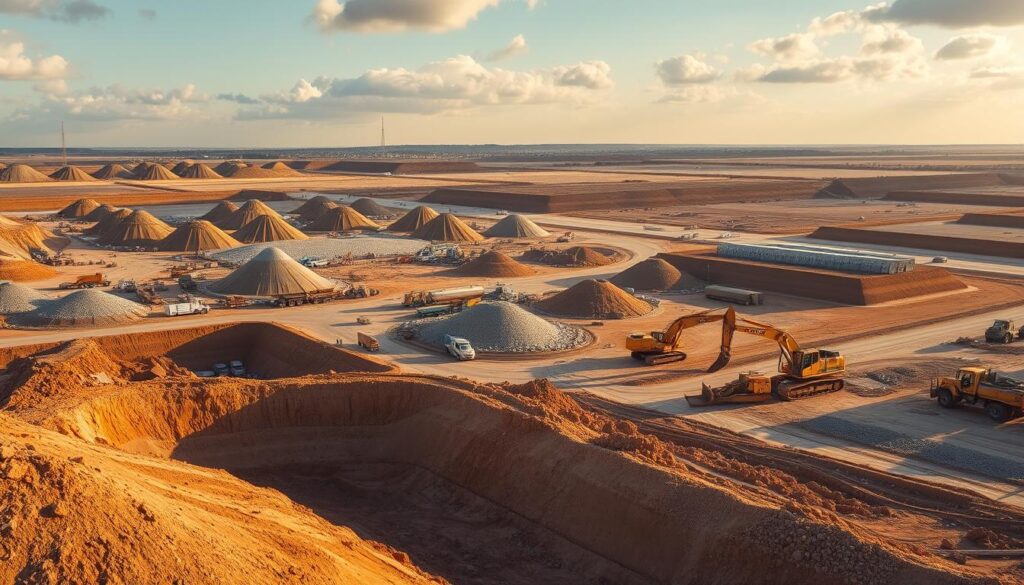
Mass Excavation and Precision Earthmoving
Mass excavation involves the removal of large quantities of soil, rock, or other materials from a site. Precision earthmoving is crucial for ensuring that the excavation is done accurately, according to the project’s specifications.
Techniques used in mass excavation include:
- Open excavation for large areas
- Trench excavation for utilities
- Basin excavation for water management
Soil Stabilization and Erosion Control
Soil stabilization is essential to prevent erosion and ensure the structural integrity of the construction site. Various techniques are employed to stabilize the soil, including mechanical and chemical methods.
| Technique | Description | Application |
|---|---|---|
| Mechanical Stabilization | Involves physically altering the soil structure | Slope stabilization, foundation support |
| Chemical Stabilization | Uses chemicals to improve soil properties | Road construction, embankments |
| Vegetation | Planting vegetation to stabilize soil | Erosion control, landscaping |
By employing these comprehensive earthwork and excavation services, construction projects can be executed efficiently, ensuring a solid foundation for subsequent construction activities.
Underground Utility Installation and Management
As cities expand and infrastructure demands grow, the importance of efficient underground utility installation cannot be overstated. Effective management of these utilities is crucial for supporting the complex networks that supply water, electricity, and communication services.
Water and Sewer Infrastructure
The installation of water and sewer infrastructure is a fundamental aspect of underground utility management. This involves the careful planning and execution of pipeline installations, ensuring that they are durable, leak-resistant, and compliant with environmental regulations. Modern techniques, such as pipe bursting and lining, are being increasingly adopted to upgrade aging infrastructure without extensive excavation.
Key considerations for water and sewer infrastructure include material selection, pipe sizing, and the implementation of inspection and maintenance protocols to prevent failures and ensure longevity.
Electrical and Communication Networks
Underground electrical and communication networks are vital for modern urban life, providing power and connectivity to homes and businesses. The installation of these networks requires precise planning to avoid interference and ensure reliability. Advanced technologies, such as fiber optic cables, are enhancing the capacity and speed of communication networks.
- Underground electrical distribution systems reduce the visual impact of power lines.
- Communication networks, including fiber optics, support high-speed data transmission.
- Coordination with other utility providers is essential to avoid conflicts during installation.
Advanced Trenchless Technology Applications
Trenchless technology has revolutionized the field of underground utility installation by minimizing surface disruption and environmental impact. Techniques such as horizontal directional drilling (HDD) and micro-tunneling enable the installation of utilities under obstacles like rivers, highways, and built-up areas.
Benefits of trenchless technology include reduced construction time, lower costs associated with surface restoration, and less disruption to local communities and ecosystems.
By embracing advanced technologies and best practices in underground utility installation and management, we can build more resilient and sustainable infrastructure for the future.
Site Development for Commercial and Industrial Projects
Site development for commercial and industrial projects is a multifaceted process that includes infrastructure development, land grading, and stormwater management. Effective site development is crucial for ensuring that the land is properly prepared for construction and future operations.
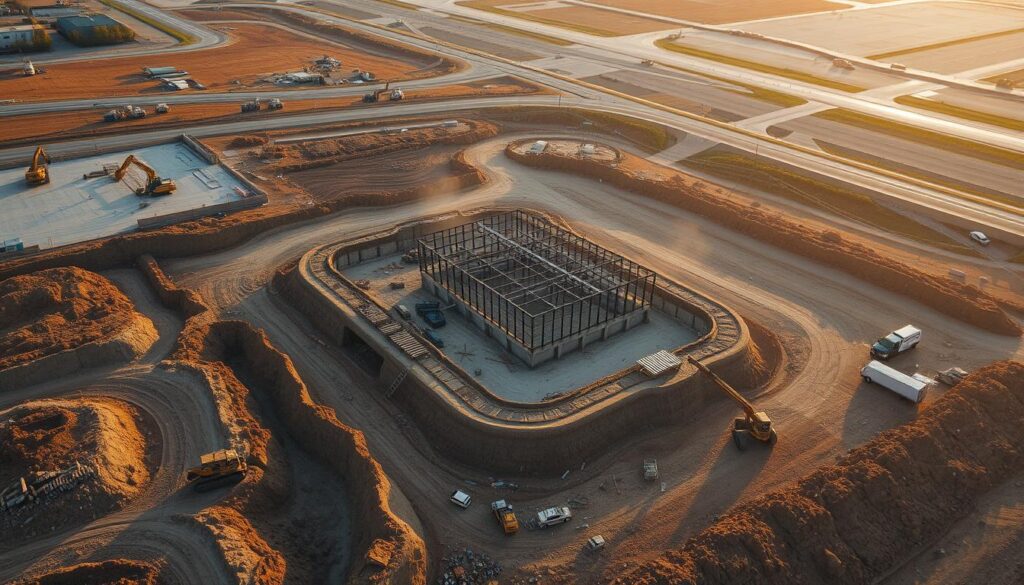
Industrial Site Infrastructure Development
Industrial site infrastructure development involves creating the foundational elements necessary for industrial operations. This includes roads, utilities, and other critical infrastructure that support the functioning of industrial facilities. Proper infrastructure development is essential for the efficient operation of industrial sites, ensuring that they can accommodate the necessary equipment and logistics.
Commercial Property Site Preparation
Commercial property site preparation is a vital step in the development of commercial real estate. It involves clearing the land, grading, and preparing the site for construction. This process ensures that the site is safe and ready for the construction of commercial buildings, such as office complexes, retail centers, and other commercial properties.
Land Grading and Stormwater Management
Land grading and stormwater management are critical components of site development. Land grading involves adjusting the terrain to ensure proper drainage and stability, while stormwater management systems are designed to handle rainwater runoff, preventing erosion and flooding. These services are essential for maintaining the integrity of the site and surrounding areas.
By integrating these services, developers can ensure that commercial and industrial sites are developed in a way that is both efficient and environmentally responsible. This not only supports the immediate construction project but also contributes to the long-term viability and sustainability of the site.
Municipal and Public Works Construction
Municipal construction projects encompass a wide range of activities, from government facility infrastructure to community development initiatives. These projects are crucial for enhancing the quality of life for residents, supporting economic growth, and ensuring the overall functionality of municipal areas.
Government Facility Infrastructure
Government facilities, such as city halls, courthouses, and public safety buildings, are essential components of municipal infrastructure. Efficient design and construction of these facilities are vital for providing effective public services. Modern government buildings not only serve as workplaces for municipal employees but also as community hubs where citizens interact with local government.
The construction of government facilities involves careful planning, adherence to regulatory standards, and the incorporation of sustainable building practices. For instance, many new government buildings are designed with energy-efficient systems and materials, reducing operational costs and environmental impact.
Parks and Public Recreational Spaces
Parks and recreational spaces are integral to the livability of urban and rural areas. They provide residents with areas for leisure, exercise, and social interaction. The development and maintenance of these spaces involve various construction activities, including landscaping, installation of recreational facilities, and construction of walking and cycling paths.
Well-designed parks can significantly enhance property values, promote physical health, and foster community cohesion. Municipalities often invest in sustainable landscaping practices and accessible recreational facilities to cater to diverse community needs.
Community Development Projects
Community development projects are aimed at improving the social, economic, and environmental well-being of communities. These projects can include the construction of community centers, public art installations, and initiatives to revitalize underutilized urban areas.
Such projects not only enhance the aesthetic appeal of neighborhoods but also contribute to social cohesion and economic vitality. They often involve collaboration between government agencies, community groups, and private developers.
| Project Type | Description | Benefits |
|---|---|---|
| Government Facility Infrastructure | Construction of city halls, courthouses, and public safety buildings | Efficient public services, community hubs |
| Parks and Recreational Spaces | Development of parks, landscaping, and recreational facilities | Enhanced livability, property values, and community cohesion |
| Community Development Projects | Construction of community centers, public art, and urban revitalization | Social cohesion, economic vitality, and aesthetic appeal |
Water Infrastructure and Management Solutions
Water management solutions are becoming increasingly important as the US faces growing water challenges. Effective management of water resources is crucial for supporting the economy, ensuring public health, and maintaining environmental sustainability.
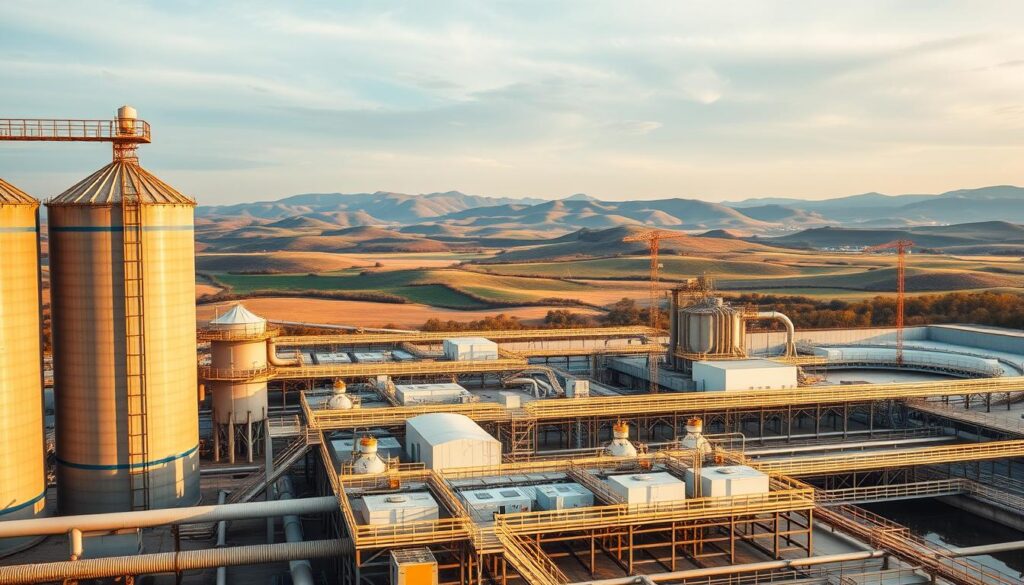
Dam Construction and Reservoir Development
Dam construction and reservoir development are critical components of water infrastructure projects. These structures play a vital role in water storage, flood control, and hydroelectric power generation. Modern dam construction techniques emphasize safety, sustainability, and minimal environmental impact.
The development of reservoirs is equally important, as they provide a buffer against droughts and help maintain a steady water supply. Advanced engineering and design are used to ensure that these reservoirs are both effective and environmentally friendly.
Flood Control and Prevention Systems
Flood control measures are essential for protecting communities and infrastructure from the devastating effects of flooding. This includes the construction of levees, floodwalls, and other protective structures. Effective flood control systems require careful planning, precise engineering, and ongoing maintenance.
In addition to structural measures, non-structural approaches such as floodplain management and early warning systems are also crucial. These comprehensive strategies help mitigate the risks associated with flooding and enhance community resilience.
Water and Wastewater Treatment Facilities
Water treatment facilities are vital for ensuring that communities have access to clean and safe drinking water. Modern treatment technologies remove contaminants and pathogens, making water safe for consumption. Wastewater treatment is equally important, as it prevents pollution and protects public health.
Advanced wastewater treatment processes not only remove pollutants but also recover valuable resources such as water and energy. This approach supports sustainability and helps close the water loop.
Specialized Heavy Civil Construction Projects
Heavy civil construction is not just about roads and bridges; it includes specialized projects like tunneling and marine construction that are pivotal for modern infrastructure development.
These projects require advanced engineering techniques, specialized equipment, and a deep understanding of the complexities involved. Let’s delve into some of the key areas:
Tunneling and Underground Structures
Tunneling and underground structures are critical components of modern infrastructure, providing essential services and connectivity. The construction of tunnels, for instance, requires precise planning and execution to ensure safety and efficiency.
- Advanced tunnel boring machines (TBMs) are used for complex tunneling projects.
- Underground structures like subway systems and utility tunnels are designed to minimize environmental impact.
- Innovative lining techniques ensure the durability and safety of tunnels.
Marine and Coastal Construction
Marine and coastal construction projects are vital for protecting coastlines, facilitating maritime trade, and supporting recreational activities. These projects involve constructing seawalls, jetties, and ports.
- Seawalls are constructed to protect coastal areas from erosion and damage.
- Jetties and breakwaters are built to facilitate safe navigation and docking.
- Port construction involves creating infrastructure for cargo handling and storage.
Railway and Transit Infrastructure
Railway and transit infrastructure are essential for efficient transportation networks, reducing congestion, and promoting sustainable travel. These projects include the construction of rail lines, stations, and maintenance facilities.
- Railway construction involves laying tracks, building embankments, and installing signaling systems.
- Transit infrastructure, such as bus rapid transit (BRT) systems, enhances urban mobility.
- Modern rail and transit projects incorporate advanced technology for improved efficiency and safety.
In conclusion, specialized heavy civil construction projects are fundamental to the development of robust and sustainable infrastructure. By leveraging advanced technologies and techniques, these projects contribute significantly to the nation’s economic and social well-being.
Heavy Equipment and Technology Integration
Technological integration and heavy equipment are revolutionizing the civil construction landscape. The effective use of advanced machinery and digital tools is crucial for the successful execution of heavy civil construction projects.
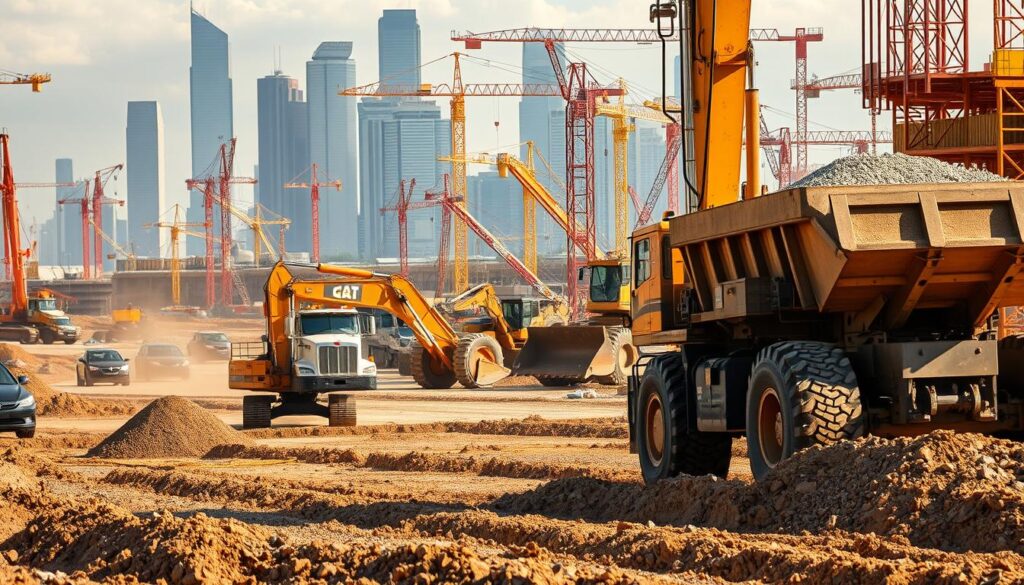
Essential Equipment Fleet for Civil Projects
A well-maintained and diverse equipment fleet is the backbone of any heavy civil construction project. This includes excavators, bulldozers, cranes, and pavers, among others. The availability of such equipment through heavy equipment rental services allows companies to access a wide range of machinery without the need for significant capital investment.
The strategic selection of equipment is critical for project efficiency. Factors such as project size, terrain, and specific construction requirements influence the choice of machinery. Modern equipment often comes equipped with advanced technology features, such as GPS and telematics, enhancing operational precision and productivity.
Digital Technology in Construction Operations
The integration of digital technology in construction has transformed the way projects are planned, executed, and monitored. Technologies such as Building Information Modeling (BIM), drones, and project management software improve collaboration, reduce errors, and increase overall project efficiency.
Digital tools enable real-time monitoring of construction operations, allowing for prompt identification and resolution of issues. This proactive approach minimizes delays and cost overruns, contributing to the successful completion of civil projects.
Equipment Management Strategies
Effective equipment management is vital for maximizing productivity and minimizing costs. This involves regular maintenance, efficient deployment, and strategic planning for equipment utilization. Advanced software and telematics play a crucial role in monitoring equipment performance and health, enabling data-driven decisions.
By adopting comprehensive equipment management strategies, construction companies can optimize their operations, reduce downtime, and improve project outcomes. This is particularly important in the context of complex civil projects, where the stakes are high and the margin for error is low.
Project Management Excellence in Heavy Civil Construction
In the complex world of heavy civil construction, project management excellence is crucial for delivering projects on time and within budget. Effective project management ensures that all aspects of the project, from planning to execution, are handled with precision and expertise.
Efficient Planning and Scheduling
Efficient planning and scheduling are the foundation of successful heavy civil construction projects. This involves creating detailed project timelines, allocating resources, and identifying potential bottlenecks. Advanced project management tools and software are utilized to streamline this process, ensuring that all stakeholders are informed and aligned.
Key elements of planning and scheduling include:
- Defining project scope and objectives
- Developing comprehensive project schedules
- Allocating resources and manpower
- Identifying and mitigating potential risks
Quality Assurance and Control Systems
Quality assurance and control are critical components of project management in heavy civil construction. These processes ensure that the project meets the required standards and specifications, and that any deviations are promptly addressed.
| Quality Control Measure | Description | Benefits |
|---|---|---|
| Regular Inspections | Conducting regular site inspections to monitor progress and quality | Early detection of defects, reduced rework |
| Material Testing | Testing materials to ensure they meet specifications | Ensures durability and safety of the structure |
| Compliance with Standards | Adhering to industry standards and regulations | Ensures legal compliance and industry best practices |
Risk Assessment and Mitigation Strategies
Risk assessment and mitigation are essential for managing the inherent risks in heavy civil construction projects. This involves identifying potential risks, assessing their impact, and developing strategies to mitigate them.
Effective risk mitigation strategies include:
- Conducting thorough risk assessments
- Developing contingency plans
- Implementing safety protocols
- Regularly reviewing and updating risk management plans
By integrating these strategies, heavy civil construction projects can be delivered successfully, meeting the required quality, safety, and environmental standards.
Regulatory Compliance and Environmental Stewardship
As heavy civil construction continues to evolve, the importance of adhering to regulatory standards and embracing environmental stewardship cannot be overstated. The industry’s impact on the environment and its compliance with regulations are under increasing scrutiny, making it crucial for companies to prioritize these aspects.

Navigating Federal and State Regulations
Heavy civil construction projects are subject to a myriad of federal and state regulations. Compliance with these regulations is not only mandatory but also critical for the success of the projects. Companies must stay abreast of the latest regulatory changes and ensure that their practices align with these requirements.
The process involves understanding the specific regulations applicable to each project, which can vary significantly depending on the project’s location and nature. For instance, projects involving water management systems or energy infrastructure may be subject to stringent environmental regulations.
Environmental Impact Assessment Processes
Conducting thorough environmental impact assessments is a crucial step in heavy civil construction projects. These assessments help identify potential environmental risks and enable companies to develop strategies to mitigate them. Effective environmental stewardship involves not just compliance with regulations but also proactive measures to minimize the project’s ecological footprint.
Environmental impact assessments typically involve evaluating the potential effects on local ecosystems, water sources, and air quality. This information is vital for planning and implementing measures to reduce adverse impacts.
Sustainable Construction Methodologies
Adopting sustainable construction methodologies is increasingly becoming a priority in heavy civil construction. Sustainable practices not only contribute to environmental stewardship but can also enhance project efficiency and reduce costs. Techniques such as using recycled materials, minimizing waste, and optimizing energy use are being adopted across the industry.
The integration of sustainable methodologies requires a holistic approach, involving careful planning, innovative technologies, and a commitment to environmental responsibility. By embracing sustainability, heavy civil construction companies can contribute to a more environmentally friendly future while maintaining project viability.
Selecting a Trusted Heavy Civil Construction Partner
The selection of a heavy civil construction company is a critical decision that impacts the entire lifecycle of your project. When embarking on complex infrastructure projects, it’s essential to partner with a contractor who possesses the right mix of experience, expertise, and resources.
Essential Qualifications and Certifications
A reputable heavy civil construction contractor should hold relevant certifications and qualifications. These may include OSHA certification, DBE or MBE certifications, and licenses specific to the state or region of operation.
Evaluating Experience and Project Portfolio
Assessing a contractor’s past projects and experience is vital. Look for a company with a proven track record in handling projects similar to yours in scope and complexity.
Understanding Contract Structures and Pricing Models
Heavy civil construction contracts can vary significantly. Common contract structures include lump sum, cost-plus, and unit price contracts. Understanding these models is crucial for managing project costs effectively.
| Contract Type | Description | Best For |
|---|---|---|
| Lump Sum | Fixed price for the entire project | Projects with well-defined scopes |
| Cost-Plus | Reimbursement for costs plus a fee | Projects with uncertain scopes or costs |
| Unit Price | Payment based on units of work completed | Projects where work quantities can vary |
By considering these factors and understanding the different contract structures and pricing models, you can make an informed decision when selecting a heavy civil construction partner.
Conclusion: The Future of Heavy Civil Infrastructure in America
The future of heavy civil infrastructure in America is poised for significant transformation, driven by technological innovation, sustainability goals, and the need for modernized transportation and utility systems. As the civil construction industry continues to evolve, it is crucial to invest in infrastructure development that supports economic growth, enhances public safety, and promotes environmental stewardship.
Heavy civil infrastructure plays a vital role in the nation’s development, from transportation networks to water management systems. The ongoing efforts to upgrade and expand this infrastructure will be critical in meeting the demands of a growing population and supporting the economy.
As the industry moves forward, embracing cutting-edge technologies and sustainable practices will be essential. This includes leveraging advancements in materials science, construction techniques, and project management to deliver infrastructure that is resilient, efficient, and environmentally friendly.
The path forward for heavy civil infrastructure in America is one of opportunity and challenge. By prioritizing infrastructure development and adopting innovative solutions, the civil construction industry can help build a stronger, more sustainable future for the nation.
